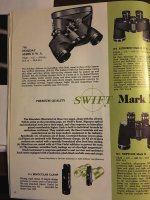elkcub
Silicon Valley, California

Interesting! Even 6x is more efficient supported than handheld. The difference in efficiency between 8x supported and handheld is quite a bit.
Yup, and that's based on experimental/laboratory data. Furthermore, with regard to wide field binoculars, the attached material comes from Swift Instruments' 1969 Catalog. The 7x35 Holiday Mk2 had a real field of 11º, and an AFOV of 77º, which they say: "delivers an incredibly wide field, equal to that of the human eye, without distortion (578ft.)"*
That's just about the same apparent field as the new Swaros. And as can be seen on the right, the 8.5x44 Audubon had a 72º AFOV, which is the same as the 8x model.
So it's been done before. The big news in my opinion is that Swaro does this while providing 18mm eye relief! Now that is fantastic!
* Clearly an exaggeration. The maximum angle a human eye can see is 150-180º (depending on the source).
Ed
Attachments
Last edited:








